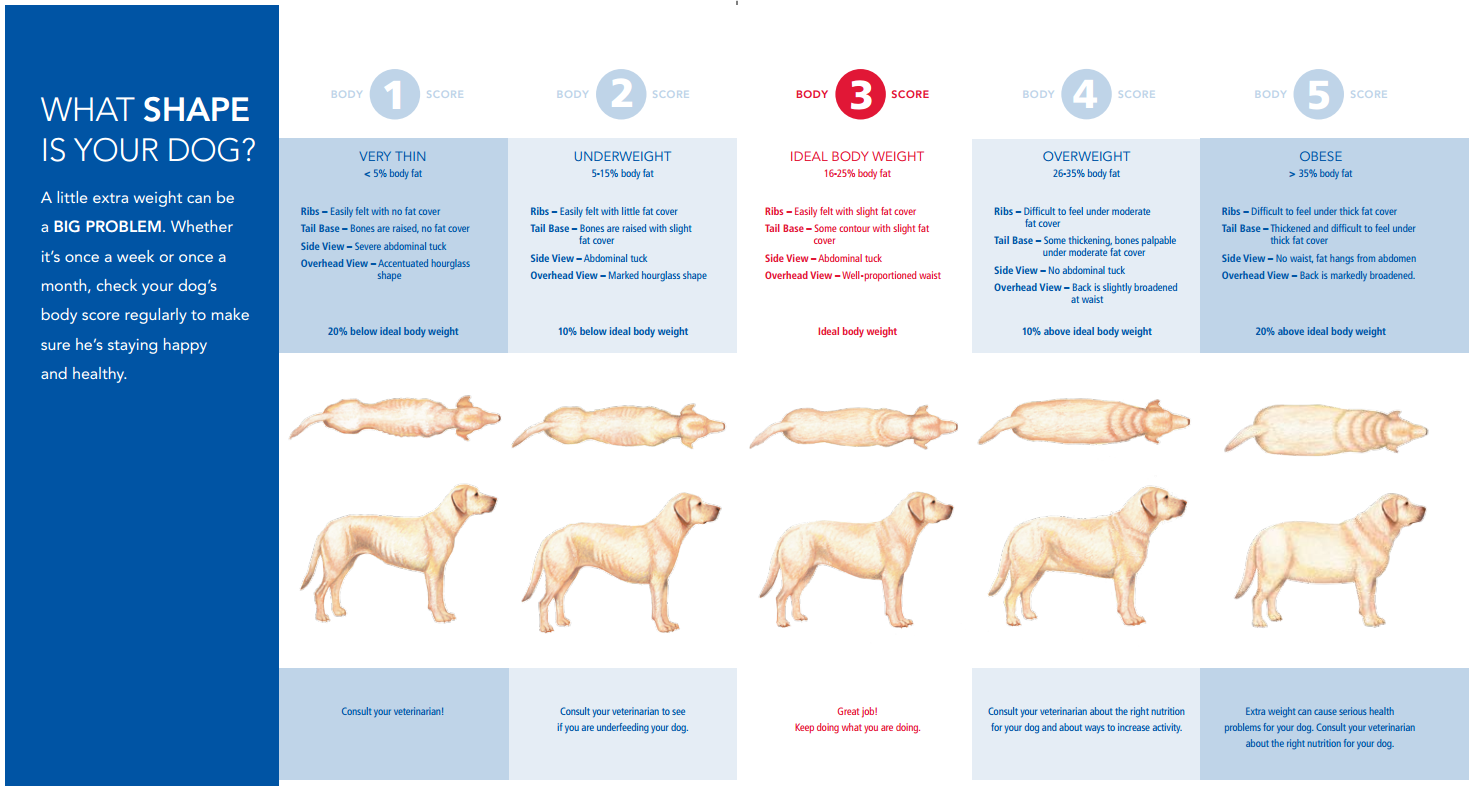Ten years ago, I adopted an adorable 11-pound American Eskimo mix from the pet shelter. She is still adorable, but maybe with a bit of extra fluff. Three months ago she weighed almost 21 pounds!
Well, I decided enough was enough. With her age only going up, I wanted the rest of her life to be as healthy and comfortable as it could be. Subsequently, the information covered in this article will be a combination of my research and recommendations from the vet who I consulted with.
Disclaimer: I am not a vet or have taken any classes. This is what I have been doing to help my dog. What has worked for her may not work for your dog. Before trying to help your furry friend lose weight you should also consult your vet to see if he/she may have medical conditions such as a thyroid issue.
The simple comprehensive guide to dechonking your dog.
1. Figure out your dog’s target caloric intake
Yes, yes, I know. You do a handful of your furiend’s kibbles, but do you really know how many calories he/she is consuming? There are two ways to do this:
Preferred way: take a food scale and weigh out the portions of food (including treats!) your dog is consuming daily and backtrack to calculate how many calories. Then put your dog on a 20% deficit from there. If your dog is at 300 calories now, cut it down to 240 calories including treats.
Here’s an example:
Look at the back of your dog’s food and it’ll come with something like: “This food contains 3,425 kcal/kg or 418 kcal/cup ME (metabolizable energy) on an as fed basis.” That means your food is 3.425 calories/gram.
Let’s say my dog eats 60 grams of her dog food a day and she also eats one turkey treat that’s 60 calories per stick.
[(grams of meal food) * (calories per gram)] + [(number of treats) * (calories per treat)] = Current calories
[60 * 3.425] + [1 * 60g] = 265.5 calories/day
Alternative:
Use a weight loss calculator. Keep in mind if your dog has a lot to lose (like my dog on the 5 scale in the dog weight chart and going from 20lb to 14lb) then you should be more liberal. In the weight loss calculator I did goal weight of 16lb.
Here is a popular one I used from Pet Nutrition Alliance.
2. Calculate the amount (by grams) needed per day
My dog’s target calories are around 212.4. For simplicity I’m going to go for 215 calories.
Use this formula:
Target calories = [(grams of meal food) * (calories per gram)] + [(number of treats desired) * (calories per treat)]
I want to give my dog 0.5 of a treat every day. As you can see, you can mix and match whatever you want. You don’t have to give any treats at all if you do not want to.
215 calories = [(grams of meal food) * 3.425 calories] + [0.5 * 60 calories]
215 calories = [(grams of meal food) * 3.425 calories] + 30 calories
185 calories = 56.21 grams of meal food
56.21 grams / 2 meals = 28 grams of food per meal
3. Mark Your Progress!
Make sure you mark your progress for your dog. If you do not see any downward changes in your dog’s weight in three weeks you might want to lower it a bit. Or check to see if anyone is sneaking them treats..
https://www.instagram.com/p/CESCa_AjB8V
FAQ’s
How do I keep my dog feeling satiated during this time?
1. Look into the kind of food you are feeding your dog and if it is high protein. You should be aiming for at least 25% protein. If you need support, you can also talk to your vet about prescription diet food.
Here’s a link to help you calculate: https://www.pawdiet.com/articles/dry-matter-basis-calculator-for-pet-food/
2. Mix veggies into the food! I personally use small diced up cucumbers into the food. There are tons of options: try green beans, cucumbers, or baby carrots.
3. Keep your dog distracted. I find that taking her to dog parks and daily walks seem to make her too tired to even look around the house for more food.
How quickly should my dog be losing weight?
Dogs don’t weigh as much as humans. I asked my vet and he mentioned that if the dog is very overweight (like a 5 on the weight scale shown in picture below) then 1lb/month is fine. But generally you would like to aim at around the 0.5lb/month if not.

Ten years ago, I adopted an adorable 11-pound American Eskimo mix from the pet shelter. She is still adorable, but maybe with a bit of extra fluff. Three months ago she weighed almost 21 pounds!
Well, I decided enough was enough. With her age only going up, I wanted the rest of her life to be as healthy and comfortable as it could be. Subsequently, the information covered in this article will be a combination of my research and recommendations from the vet who I consulted with.
Disclaimer: I am not a vet or have taken any classes. This is what I have been doing to help my dog. What has worked for her may not work for your dog. Before trying to help your furry friend lose weight you should also consult your vet to see if he/she may have medical conditions such as a thyroid issue.
The simple comprehensive guide to dechonking your dog.
1. Figure out your dog’s target caloric intake
Yes, yes, I know. You do a handful of your furiend’s kibbles, but do you really know how many calories he/she is consuming? There are two ways to do this:
Preferred way: take a food scale and weigh out the portions of food (including treats!) your dog is consuming daily and backtrack to calculate how many calories. Then put your dog on a 20% deficit from there. If your dog is at 300 calories now, cut it down to 240 calories including treats.
Here’s an example:
Look at the back of your dog’s food and it’ll come with something like: “This food contains 3,425 kcal/kg or 418 kcal/cup ME (metabolizable energy) on an as fed basis.” That means your food is 3.425 calories/gram.
Let’s say my dog eats 60 grams of her dog food a day and she also eats one turkey treat that’s 60 calories per stick.
[(grams of meal food) * (calories per gram)] + [(number of treats) * (calories per treat)] = Current calories
[60 * 3.425] + [1 * 60g] = 265.5 calories/day
Alternative:
Use a weight loss calculator. Keep in mind if your dog has a lot to lose (like my dog on the 5 scale in the dog weight chart and going from 20lb to 14lb) then you should be more liberal. In the weight loss calculator I did goal weight of 16lb.
Here is a popular one I used from Pet Nutrition Alliance.
2. Calculate the amount (by grams) needed per day
My dog’s target calories are around 212.4. For simplicity I’m going to go for 215 calories.
Use this formula:
Target calories = [(grams of meal food) * (calories per gram)] + [(number of treats desired) * (calories per treat)]
I want to give my dog 0.5 of a treat every day. As you can see, you can mix and match whatever you want. You don’t have to give any treats at all if you do not want to.
215 calories = [(grams of meal food) * 3.425 calories] + [0.5 * 60 calories]
215 calories = [(grams of meal food) * 3.425 calories] + 30 calories
185 calories = 56.21 grams of meal food
56.21 grams / 2 meals = 28 grams of food per meal
3. Mark Your Progress!
Make sure you mark your progress for your dog. If you do not see any downward changes in your dog’s weight in three weeks you might want to lower it a bit. Or check to see if anyone is sneaking them treats..
View this post on InstagramA post shared by Suki (@happygosuki) on
FAQ’s
How do I keep my dog feeling satiated during this time?
1. Look into the kind of food you are feeding your dog and if it is high protein. You should be aiming for at least 25% protein. If you need support, you can also talk to your vet about prescription diet food.
Here’s a link to help you calculate: https://www.pawdiet.com/articles/dry-matter-basis-calculator-for-pet-food/
2. Mix veggies into the food! I personally use small diced up cucumbers into the food. There are tons of options: try green beans, cucumbers, or baby carrots.
3. Keep your dog distracted. I find that taking her to dog parks and daily walks seem to make her too tired to even look around the house for more food.
How quickly should my dog be losing weight?
Dogs don’t weigh as much as humans. I asked my vet and he mentioned that if the dog is very overweight (like a 5 on the weight scale shown in picture below) then 1lb/month is fine. But generally you would like to aim at around the 0.5lb/month if not.


